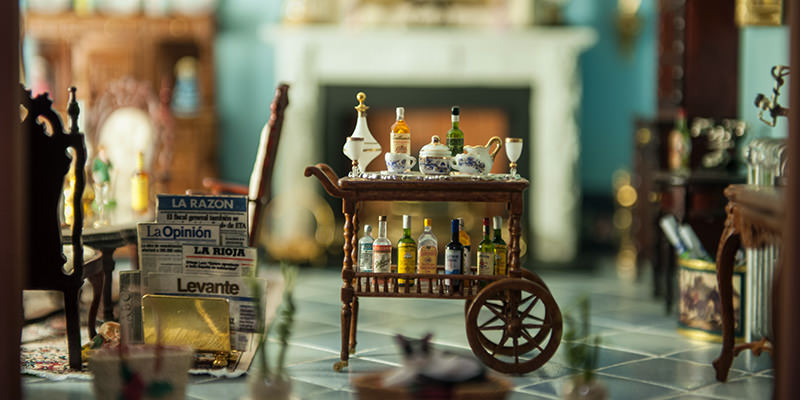When it comes to Mid-Century holdovers, there’s one thing that we can all agree upon: folks certainly knew how to drink. A good home bar was not only a social staple, but also a design essential. Lucky for us, the bar cart is making a comeback, and if you’re a fan of drinking, entertaining, or just beautiful things, you should definitely get on board. When assembled thoughtfully, the bar cart can serve both as a useful storage tool and a beautiful focal point in the living room area. (Or sleeping area. No judgment here.)
Here’s the rub: building a full bar isn’t cheap. Good booze and all the corresponding cocktail accoutrements can snowball and end up becoming more of a burden than a joy. The great news is that if you stay smart and curated, collecting the essentials to get you started can be far less expensive than you might think.
For the purpose of this guide, let’s agree to think of “Bar Cart” as a euphemism. Whether it’s a spare bookshelf or a repurposed side-table from your aunt’s basement, your bar should live wherever makes the most sense for you and your budget.
Now that your bar has a home, you only need to focus on two non-booze essentials to stock your cart: glassware and tools.
Glassware
Don’t get overwhelmed. Just start by accumulating a small variety of sizes that can accommodate anyone’s cocktail of choice: 4 short 4 oz glasses for sipping neat, 4 mid-range 6-8 oz glasses for lowball cocktails, and If you’re a martini fan, go ahead and add a few of those to your collection. For serving ice-loaded drinks or wine, you can save by using your regular home glasses.
And building your collection doesn’t have to be particularly pricey. If you’re into an eclectic look, check out Etsy or vintage stores that sell glasses individually. If full sets are more your thing, head directly to your nearest restaurant supply store for nearly-wholesale prices.
Tools
Avoid going overboard, and simply stick to the basics: A shaker, strainer, bar spoon, mixing glass, and a 2 oz (or less) jigger. You’ll need to play around with these tools to figure out where you can skimp and where you’ll want to spend a bit more. I prefer a beaker to a mixing glass because they’re cheap, nearly indestructible, and give your bar a slight Breaking Bad vibe. And when it comes to shakers, everyone has an opinion, but if you’re looking to consolidate spending, I like the Cobbler for it’s built in strainer.
With those few tools you should be able to make the vast majority of basic cocktails. Some insist on paring knives and cutting boards, but like larger glasses, those also theoretically already exist in your kitchen.
Booze Basics
Now you’re ready to start adding the good stuff. When selecting liquors, concentrate on finding quality without the steep price tag. There are myriad booze options out there, some of which should never come off the rail and others that should be hidden, even from the dearest of family members. Your bar cart should be populated by that swath in the middle.
Start with the 7 essentials: rum, gin, vodka, whiskey, vermouth (sweet & dry) and bitters. From there, I’d argue adding a tequila and a mezcal, because there’s really no substitute for agave. Those liquors plus fresh citrus will allow you to mix everything from Martinis and Manhattans to Palomas and Daquiris. If your friends require more than that from you, you should consider getting new friends.
Selecting Spirits
Talk to your favorite bartenders or liquor store employees, see what they’re excited about, and try to stay away from the big brands. Trade in Absolut for something similarly priced, but way more interesting like Reyka ($21), which is made by Iceland’s only master distiller. Watch how fast you become the arbiter of all things cool and boozy.
Save on the basics and splurge on your drink(s) of choice. I like to balance Willet Rye ($45) with a solid London Dry like Broker’s ($22), and saving on a rum that gives a ton of bang for the buck, such as the El Dorado 3 Year ($15), makes the Fortaleza Blanco Tequila ($55) go down even smoother.
If you’re just starting out with bitters and vermouth, stick with the tried and true. Dolin Dry Vermouth and Martini Rosso Red Vermouth will do the trick for manhattans and martinis, and Angostura Bitters will keep your old fashioned nice and classic.
All in, a bar certainly isn’t going to be a particularly cheap investment, but building a killer bar cart doesn’t have to cost a mint. Identify the places that you’re willing to spend a bit more, and just fill out the rest with quality items that won’t break the bank. Trust me, no matter what you end up with on your cart, your guests will thank you.

